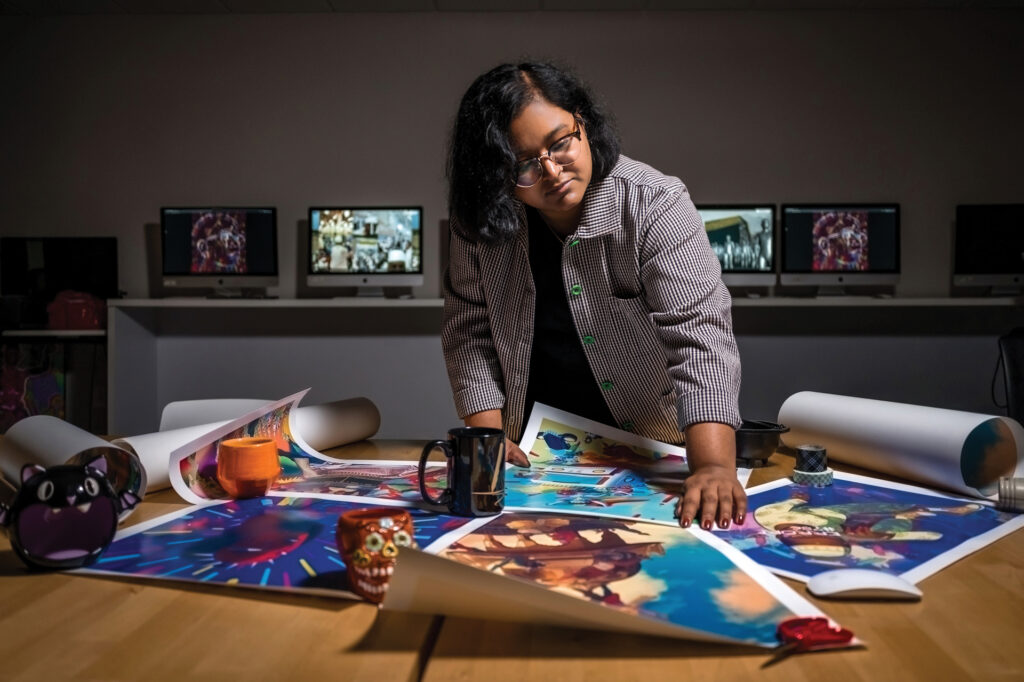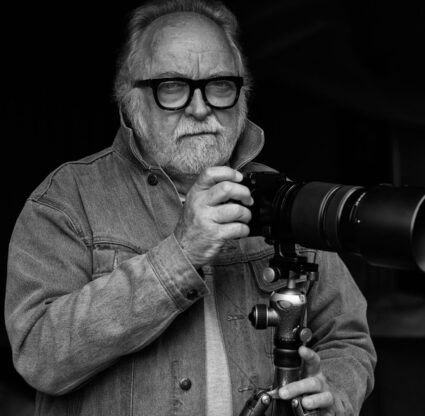Mixed-media artist Shimul Chowdhury recalls a seemingly innocuous survey she participated in as a graduate student at the University of California, Santa Cruz. “On a scale of one to 10, I was asked, ‘How much do you feel you belong?’” Shimul says. “I felt that wasn’t enough—as a Muslim person, as a woman, as a person of color.”
Now living in Fort Myers, that simple question is a keystone in the second-generation Bangladeshi-American’s studio practice, which revolves around identity and multicultural crossroads. She teaches digital media, from game design to emerging technologies, at Florida SouthWestern State College. In her studio, Shimul taps into software programs, such as 3D modeling tool Maya and video game development software Unreal Engine to create videos, illustrations and projections with overlapping animated scenes.
Sometimes, she juxtaposes the imagery with embroidery or other textile work. In 2021’s Noise, a softly pixelated self-portrait undulates; in 2015’s video montage #worship, she intersperses footage of a pilgrimage her father shot on his smartphone with 3D renderings of men standing and kneeling in prayer.
Her work turns the conventional, one-sided art-viewing experience on its head, encouraging audience participation. “I’ve always been interested in interactivity and the reciprocal—rather than the passive—relationship between the artist and audience,” Shimul says. She may manipulate software circuits so that the artwork’s imagery moves in response to the presence of a hand. The connection between the audience and creator is as pivotal in her work as in the video games she helps her students create.
“When my mom immigrated to the States, my dad purchased a Super Nintendo so she could learn English when she was pregnant with my brother and me,” Shimul says with a grin. “I’ve been playing video games as long as I can remember, especially with my mom.” After growing up primarily on Florida’s east coast, she enrolled at the University of Florida and majored in computer science. However, she was most drawn to the elaborate storylines and illustrations in her beloved video games and shifted to pursue a studio art degree with a concentration in art and technology. “Folks still tend to create this binary between fine art and digital art and don’t see digital art as a mode and a method that exists within the same realm,” she says. “The tools I use—whether it’s my computer, electronic circuits or a video camera—are tools like a graphite pencil or a paintbrush.”
As a graduate student in Santa Cruz a few years later, Shimul Chowdhury began developing her thesis, Stitching Solidarity, which urged her to meld tactile art into her digital work. “I’ve used craft as a mode of relief,” she says. “I learned how to sew by hand and machine from my mother at a young age, and I taught myself crocheting and knitting in my teenage years.” Her mother sewed Shimul’s childhood clothing and traditional kanthas—hand-embroidered South Asian quilts made from repurposed saris.
Stitching Solidarity featured video interviews with 11 Muslim-Americans projected within a tent assembled with kanthas Shimul made from her mother’s saris. In the center, she placed an embroidery hoop with bare, blank fabric, where viewers were asked to record their response to a prompt that still haunts her: Stitch or write a word or phrase that represents a sense of belonging.
Six months after completing her master’s program, Shimul Chowdhury joined MIPSTERZ, a Muslim art and culture collective, where she found her place. (MIPSTERZ founder Abbas Rattani half-jokingly coined the term Mipsterz, combining ‘Muslim’ with ‘hipsters.’) MIPSTERZ members don’t need to preface every project pitch by explaining its connection to Islam—something she’d found tiring and time-consuming with peers of different ethnicities at UC Santa Cruz.
Shimul’s one of three core organizers who run the international collective. Each organizer contributes traditions and experiences from their respective countries. “That’s what gets left out of the conversation so often: Other groups get treated as multidimensional identities, but Muslims are treated as a singular entity,” she says. “We’re not here to speak to the theological end or define who is or isn’t Muslim, but we want to use our shared cultural experience to connect and show that ‘Muslim’ can mean so many things.”
In 2021, Shimul Chowdhury collaborated with fellow MIPSTERZ members to create the immersive, choice-based installation The Mirage at Duke University’s Rubenstein Arts Center in Durham, N.C. After scanning a QR code, viewers select a single word from 15 options, ranging from ‘indifference’ to ‘harmony,’ to share how they’d contribute to a future in which marginalized communities were emphasized and celebrated. Then they enter a dark room, where videos project onto fluttering cloth panels. Islamic music plays in tandem with a range of imagined Muslim future worlds and its people; the scene flashes kaleidoscopically with uplifting phrases in English and Arabic text, arranged in patterns evoking Islamic tiles. The phrases, tailored by the viewer’s survey response, come from the Quran, poetry and colloquial expressions. Like a video game, The Mirage doesn’t just begin and end with the viewer’s interaction but exists because of it. “It’s cathartic to make work about my own lived experience and process my own emotions,” she says. “For so many folks—true of young Muslim folks or any young person of marginalized identity—creativity in any form can be so freeing.”





